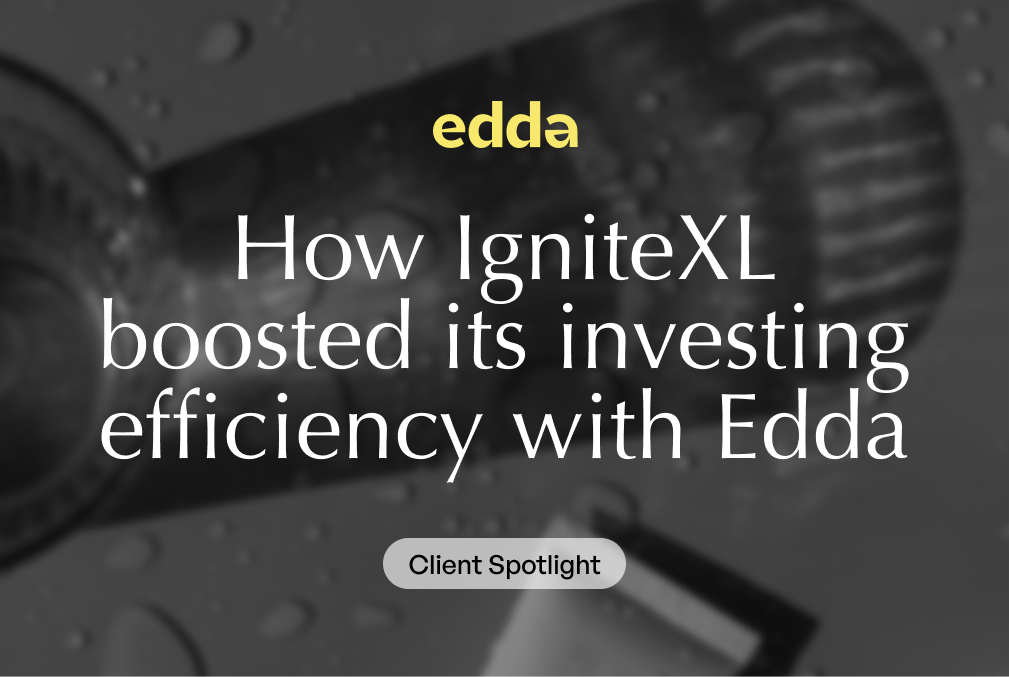In the universe of investment, decision-makers continually confront an array of options for asset allocation, each with its unique risk and return profile. An insightful approach for refining these choices can be found in the Fama-French Three-Factor Model, an extension of the Capital Asset Pricing Model (CAPM).
This article delves into the essential elements of this model, exploring how it enriches the analytical process for asset selection and contributes to portfolio optimization. Furthermore, discover how Edda’s business venture software and deal sourcing platform incorporates the Fama-French Three-Factor Model to streamline asset allocation and deal evaluation.
Understanding the Fama-French Three-Factor Model
Building upon the CAPM, which primarily accounts for market risk, the Fama-French model introduces two additional variables: the size effect and the value effect. These added layers allow the model to account for discrepancies in stock returns that are not adequately explained by market risk alone.
Size Effect
One of the additional layers introduced by Fama and French is the size effect, or SMB (Small Minus Big). The premise is rather straightforward: smaller firms, usually measured by their market capitalization, often yield greater returns compared to their larger counterparts over a given period, when all other considerations are held constant.
The phenomenon is thought to arise because smaller companies generally entail greater risk and less market liquidity; investors demand higher returns as compensation for taking on this additional level of risk. Thus, the Fama-French model incorporates the size effect to improve its predictive accuracy concerning stock returns.
Value Effect
The second supplemental component is the value effect, or HML (High Minus Low), which aims to capture the excess returns of value stocks over growth stocks. The distinguishing feature between value and growth stocks generally lies in their respective price-to-book ratios. Stocks that exhibit lower price-to-book ratios are categorized as value stocks.
These are often mature companies with stable but slower growth prospects. Conversely, growth stocks typically have high price-to-book ratios and are expected to achieve substantial earnings or revenue growth. The value effect posits that the former category of stocks tends to outperform the latter over the long term. This finding challenges the traditional efficient-market hypothesis by demonstrating persistent anomalies in stock returns that are not linked to market risk.
Incorporating these two additional factors into the formula, the Fama-French model becomes more adept at explaining variations in stock returns that CAPM cannot sufficiently account for. Instead of relying solely on market risk, the Fama-French model adopts a broader and more nuanced scope. It considers the idiosyncrasies of company size and stock valuation, thereby offering a more comprehensive framework for estimating expected returns.
Asset Selection and Portfolio Optimization
The first area of application is in asset selection and portfolio optimization. The model furnishes investors with an advanced method for scrutinizing a wide array of investment options, considering not only market risk but also the additional dimensions of size and value.
Investors can utilize this augmented understanding to sift through an extensive pool of potential investment avenues. This becomes particularly salient in an environment where investment options are abundant but often complex and hard to navigate.
The Fama-French model can serve as an analytical compass, guiding investors toward securities that match their specific criteria and helping to evade pitfalls associated with investing based solely on market risk.
Special Cases: Emerging Markets and High Concentration of Small-Cap Stocks
The model’s capabilities are also notably potent when dealing with specialized investment scenarios, such as emerging markets or sectors rich in small-cap stocks. Both these categories present idiosyncratic risks and opportunities that are not wholly captured by market risk alone.
Emerging Markets: These markets are often characterized by increased volatility and less mature financial systems. Traditional models like the CAPM may provide skewed or incomplete pictures of risk in these contexts. The Fama-French model, by incorporating the additional factors of size and value, can offer investors a more nuanced understanding of the risks and potential rewards involved.
Sectors with High Concentration of Small-Cap Stocks: Industries like technology startups or green energy often comprise a multitude of smaller firms. In such sectors, the size effect becomes an influential determinant of stock returns. Investors can employ the Fama-French model to more accurately gauge the risk profiles and expected returns of these small-cap stocks.
Enhanced Asset Allocation
By equipping investors with a more comprehensive risk-return framework, the Fama-French model contributes significantly to the asset allocation process. Understanding how size and value factors affect individual securities can lead to better diversification strategies. Investors can assemble portfolios that are not only expected to yield satisfactory returns but are also cognizant of the various sources of risk involved. This results in portfolios that are more resilient to market shocks and turbulence, with risk distributed across multiple dimensions rather than concentrated in one.
Implementing the Fama-French Three-Factor Model
Suppose an investment firm wishes to diversify its portfolio by considering international equities. The firm has shortlisted a few companies with varying market capitalizations and growth prospects.
The formula for the expected return according to the Fama-French Three-Factor Model can be expressed in words as follows:
The expected return of a stock or portfolio is equal to the risk-free rate plus the product of the stock’s Beta coefficient and the market risk premium. This sum is further augmented by the product of the stock’s sensitivity to the size effect, denoted as ‘s’, and the difference in returns between small-cap and large-cap stocks, commonly known as ‘Small Minus Big’ or SMB. Lastly, this sum is incremented by the product of the stock’s sensitivity to the value effect, represented by ‘v’, and the difference in returns between high book-to-market and low book-to-market stocks, known as ‘High Minus Low’ or HML.
In this equation:
- The “expected return” refers to the anticipated profit or loss on the investment.
- The “risk-free rate” usually corresponds to the yield of a government bond matching the investment’s time horizon.
- “Beta coefficient” quantifies the stock’s responsiveness to overall market movements.
- “Market risk premium” is calculated as the difference between the expected market return and the risk-free rate.
- “SMB” stands for Small Minus Big, representing the excess returns of small-cap stocks over large-cap stocks.
- “HML” stands for High Minus Low, encapsulating the excess returns of value stocks over growth stocks.
- “s” denotes the stock’s or portfolio’s sensitivity to the size effect.
- “v” denotes the stock’s or portfolio’s sensitivity to the value effect.
To apply the Fama-French model, the firm can analyze the selected stocks’ historical returns while accounting for market risk, size effect, and value effect. This application will offer a more holistic view of the stocks’ past performance and provide critical inputs for predicting future returns. Armed with this data, the firm can make more informed decisions about which international equities to include in its portfolio.
Limitations and Considerations
As with any financial model, the Fama-French Three-Factor Model comes with its set of shortcomings. One limitation is its historical nature; the model relies heavily on past performance data, which may not always be a reliable indicator of future returns. Additionally, the size and value factors can themselves be influenced by market conditions, diminishing the model’s accuracy during extreme market events.
Moreover, the model assumes that all investors operate under the same information umbrella, an assumption that is often contradicted by information asymmetry and behavioral biases in the real world. Thus, the model should be employed judiciously, as one piece in a broader analytical jigsaw, rather than as an independent determinant for investment decisions.
Edda’s Portfolio Management Software and the Fama-French Model
What is the best software for investment portfolio management?
Edda’s venture capital portfolio management software incorporates the Fama-French Three-Factor Model into its asset selection and deal-sourcing algorithms. The software collates real-time data on market risk, size, and value variables to generate highly tailored asset allocation and expected return reports. By using this model in conjunction with other analytical tools, Edda provides a robust and all-encompassing dealflow solution for venture capital firms seeking to optimize their investment strategies.
In addition to its analytical capabilities, Edda’s platform includes a specialized deal flow CRM for venture capital, contributing to operational cohesion by negating the need for multiple systems. The integration of the Fama-French model into Edda’s software venture capital suite demonstrates the platform’s commitment to applying rigorous financial theories for practical investment applications, leading to more effective portfolio management and well-informed investment choices.
By incorporating a variety of financial theories, including the Fama-French Three-Factor Model, Edda’s investment portfolio software offers an invaluable asset for firms aiming to strengthen their investment strategies and achieve superior returns.









